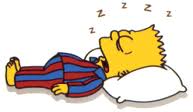
Sleeping and driving. According to a report by the National Sleep Foundation’s Sleep and Teens Task Force: “Drowsiness or fatigue has been identified as a principle cause in at least 100,000 police-reported traffic crashes each year, killing more than 1,500 Americans and injuring another 71,000, according to the National Highway Traffic Safety Administration (NHTSA, 1994). Young drivers age 25 or under cause more than one-half of fall-asleep crashes. A North Carolina state study found that drivers age 25 or younger cause more than one-half (55 percent) of fall-asleep crashes … 78% were males. The peak age of occurrence was 20.”
Teen sleep needs. Adolescents require at least as much sleep as they did as pre-adolescents — in general, 8.5 to 9.25 hours each night. (Mary Carskadon, Brown University, et al., 1980)
Up all night (or, the vampire thing). Adolescents’ sleep patterns undergo a phase delay, that is, a tendency toward later times, for both sleeping and waking. Studies show that the typical high school student’s natural time to fall asleep is 11 p.m. or later. (Amy R. Wolfson, College of the Holy Cross, and Carskadon, 1998)
Your kids are right — school does start too early. Most high schools in Charlotte and the Triangle start between 7:15 a.m. and 7:30 a.m. The National Sleep Foundation advocates “Legislation to encourage starting high schools no earlier than 9 a.m.” The NSF also supports graduated licensing regulations to reduce the number of adolescents driving unsupervised at night (already in place in North Carolina) as well as child labor laws to restrict the number of hours and the time of day that adolescents are permitted to work.
What, did some high school kid come up with that 9 a.m. thing? No. The University of Minnesota’s Center for Applied Research and Educational Improvement has studied the issue (Kyla Wahlstrom and C.M. Freeman, 1997) and found that in high schools that start later:
- In suburban districts, students gain an extra hour of sleep each school day.
- Teachers report that more students are alert during the first two periods of the day, and fewer students fall asleep at their desks.
- More homework gets done during school hours because students are more alert and efficient during the day.
- Attendance increases and tardiness decreases.
- Some students reported eating breakfast more frequently.
- Teachers in suburban districts report noticeable improvements in student behavior: quieter hallways between classes and less misbehavior in the lunchroom.
- Counselors from suburban schools describe the school atmosphere as “calmer,” and report that fewer students seek help for stress relief due to academic pressures. (Urban teachers, however, observed no general improvement in student behavior.)
- A downside in urban districts: fewer students were involved in extracurricular and social activities, and the later school schedules resulted in conflicts or compromised earnings for students who worked after school.
Less time for afternoon mischief. National studies and analysis of data from the Federal Bureau of Investigation reveal that on school days, 45 percent of juvenile violent crime takes place between 2 and 8 p.m., with the sharpest rise occurring between 2 and 4 p.m. (Wahlstrom and Freeman, 1997; CSPV, 1998). (A 9 a.m. start would mean students being in school until about 4 p.m.) Also during these times: unsupervised adolescents are more likely to engage in acts of violence, as well as sex and recreational use of alcohol or drugs.
Pointers for Parents. From the National Sleep Foundation Sleep and Teens Task Force come these suggestions for parents to help their teens get a full night’s sleep.
- Educate yourself about adolescent development, including physical and behavioral changes you can expect (especially those that relate to sleep needs and patterns).
- Look for signs of sleep deprivation and sleepiness in your teens. Signs include: difficulty waking in the morning, irritability late in the day, falling asleep spontaneously during quiet times of the day, sleeping for extra long periods on the weekends.
- Enforce and maintain age-appropriate sleep schedules for all children.
- Talk with your kids. Look at their extracurricular and employment activities and see how it affects their sleep patterns. If there’s a problem, work with them to adjust their schedules to allow for enough sack time.
- Provide a home environment conducive to healthy sleep. Establish a quiet time in the evening when the lights are dimmed and loud music is not permitted. Do not allow use of the television, computer and telephone within an hour of bedtime. Keep the evening temperature of your house a sleep-friendly 68 to 70 degrees.
- Get enough sleep yourself. Even sleeping, you can be a good role model.
Tips for Teens. Here’s what the National Sleep Foundation Sleep and Teens Task Force suggests for teens.
- Sleep is food for the brain. Lack of sleep can make you look tired and feel depressed, irritable or angry. Even mild sleepiness can hurt your performance — from taking school exams to playing sports or video games. Learn how much sleep you need to function at your best … and strive to get it every night. You should awaken refreshed, not tired.
- Establish a routine, with a regular bedtime and wake time, and try to maintain that routine through the school week, the weekend, on those ubiquitous teacher work days and on vacation.
- Get into bright light as soon as possible in the morning, but avoid it in the evening. Light signals to the brain when it should wake up and when it should prepare to sleep.
- Understand your circadian rhythms. Then you can try to maximize your schedule throughout the day according to your internal clock.
- After lunch/noon stay away from caffeinated coffee and colas.
- Relax before going to bed. Avoid heavy reading, studying and computer games within one hour of bed. Don’t fall asleep with the television on — flickering light and stimulating content can inhibit restful sleep.